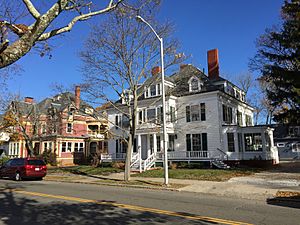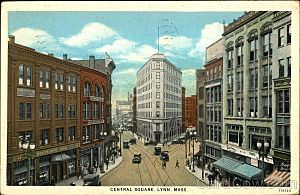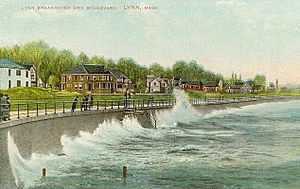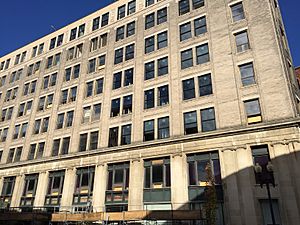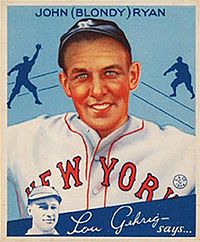Lynn, Massachusetts facts for kids
Quick facts for kids
Lynn, Massachusetts
|
||
|---|---|---|
|
City
|
||
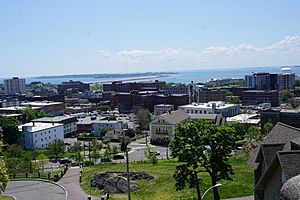
Downtown Lynn
|
||
|
||
| Nicknames:
City of Sin; City Of Firsts
|
||
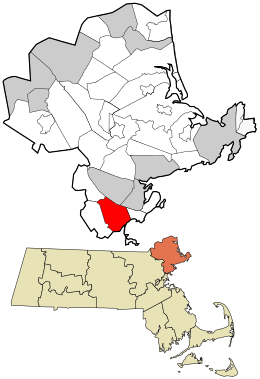
Location in Essex County and the state of Massachusetts.
|
||
| Country | United States | |
| State | Massachusetts | |
| County | Essex | |
| Settled | 1629 | |
| Incorporated (Town) | 1629 | |
| Named | 1637 | |
| Incorporated (City) | May 14, 1850 | |
| Named for | King's Lynn, Norfolk, England | |
| Government | ||
| • Type | Mayor-council city | |
| • Body | Executive Branch (Mayor) and Legislative Branch (City Council) | |
| Area | ||
| • Total | 13.53 sq mi (35.03 km2) | |
| • Land | 10.74 sq mi (27.83 km2) | |
| • Water | 2.78 sq mi (7.20 km2) | |
| Elevation | 30 ft (9 m) | |
| Population
(2020)
|
||
| • Total | 101,253 | |
| • Density | 8,776.90/sq mi (3,388.92/km2) | |
| Demonym(s) | Lynner | |
| Time zone | UTC−5 (Eastern) | |
| • Summer (DST) | UTC−4 (Eastern) | |
| ZIP Codes |
01901–01905
|
|
| Area codes | 339/781 | |
| FIPS code | 25-37490 | |
| GNIS feature ID | 0613376 | |
Lynn is the 8th largest municipality in Massachusetts and the largest city in Essex County. Situated on the Atlantic Ocean, 3.7 miles (6.0 km) north of the Boston city line at Suffolk Downs, Lynn is part of Greater Boston's urban inner core. Settled by Europeans in 1629, Lynn is the 5th oldest colonial settlement in the Commonwealth. An early industrial center, Lynn was long colloquially referred to as the "City of Sin", owing to its historical reputation for crime. Today, however, the city is known for its contemporary public art, immigrant population, historic architecture, downtown cultural district, loft-style apartments, and public parks and open spaces, which include the oceanfront Lynn Shore Reservation; the 2,200-acre, Frederick Law Olmsted-designed Lynn Woods Reservation; and the High Rock Reservation and Park designed by Olmsted's sons. Lynn also is home to Lynn Heritage State Park, the southernmost portion of the Essex Coastal Scenic Byway, and the seaside, National Register-listed Diamond Historic District. The population was 101,253 at the time of the 2020 United States Census.
Contents
History
17th century
Prior to European colonization, the area today known as Lynn was inhabited by the Naumkeag people. European settlement of the area was begun in 1629 by Edmund Ingalls, followed by John Tarbox of Lancashire in 1631. The English settled Lynn not long after the 1607 establishment of Jamestown, Virginia--the first successful English colony in North America--and the 1620 arrival of the Mayflower at Plymouth. The area today encompassing Lynn was originally incorporated in 1631 as Saugus, the Nipmuck name for the area.
A noteworthy early Lynn colonist, Thomas Halsey, left Lynn to settle the East End of Long Island, where he founded the Town of Southampton, New York. The resulting Halsey House—the oldest extant frame house in New York State (1648)--is now open to the public, under the aegis of the Southampton Colonial Society.
Further European settlement of Lynn led to several independent towns being formed, with Reading created in 1644, Lynnfield in 1782, Saugus in 1815, Swampscott in 1852, and Nahant in 1853. The City of Lynn was incorporated in 1850, taking its name from King's Lynn, Norfolk, England, in honor of Samuel Whiting.
Colonial Lynn was an early center of tannery and shoe-making, which began in 1635. The boots worn by Continental Army soldiers during the Revolutionary War were made in Lynn, and the shoe-making industry drove the city's growth into the early nineteenth century. This legacy is reflected in the city's seal, which features a colonial boot.
19th century
In 1816, a mail stage coach was operating through Lynn. By 1836, 23 stage coaches left the Lynn Hotel for Boston each day. The Eastern Railroad Line between Salem and East Boston opened on August 28, 1838. This was later merged with the Boston and Maine Railroad and called the Eastern Division. In 1847 telegraph wires passed through Lynn, but no telegraph service station was built until 1858.
During the middle of the nineteenth century, estates and beach cottages were constructed along Lynn's shoreline, and the city's Atlantic coastline became a fashionable summer resort. Many of the structures built during this period are today situated within the National Register-listed Diamond Historic District.
Further inland, industrial activity contemporaneously expanded in Lynn. Shoe manufacturers, led by Charles A. Coffin and Silas Abbott Barton, invested in the early electric industry, specifically in 1883 with Elihu Thomson and his Thomson-Houston Electric Company. That company merged with Edison Electric Company of Schenectady, New York, forming General Electric in 1892, with the two original GE plants being in Lynn and Schenectady. Coffin served as the first president of General Electric.
Initially the General Electric plant specialized in arc lights, electric motors, and meters. Later it specialized in aircraft electrical systems and components, and aircraft engines were built in Lynn during WWII. That engine plant evolved into the current jet engine plant during WWII because of research contacts at MIT in Cambridge. Gerhard Neumann was a key player in jet engine group at GE in Lynn. The continuous interaction of material science research at MIT and the resulting improvements in jet engine efficiency and power have kept the jet engine plant in Lynn ever since.
One of the largest strikes of the early labor movement began in the shoe factories of Lynn on February 22, 1860, when Lynn shoemakers marched through the streets to their workplaces and handed in their tools, protesting reduced wages. Known as the New England Shoemakers Strike of 1860, it was one of the earliest strikes of its kind in the United States.
On February 1, 1866, Mary Baker Eddy experienced the "fall in Lynn", often referred to by Christian Scientists as significant in the birth of their religion.
20th century
Lynn experienced a wave of immigration during the late 1800s and early 1900s. During the 30 years between 1885 and 1915, Lynn's immigrant population increased from 9,800 to 29,500, representing nearly one-third of the city's total population. Polish and Russian born Jews were the largest single group, numbering more than 6,000. The first Jewish settlers in Lynn, a group of twenty Hasidic European families, mostly Russian, formed the Congregation Anshai Sfard, a Hasidic, conservative Jewish synagogue in 1888. Catholic churches catering to the needs of specific language and ethnic groups also testify to the waves of immigrants. St. Jean Baptiste parish, eventually including a grammar school and high school, was founded in 1886, primarily for French-Canadians. Holy Family Church conducted services in Italian beginning in 1922, and St. Michael's church also provided church services and a grammar school for the Polish-speaking community, beginning in 1906. St. Patrick's church and school was a focus of the Irish-American community in Lynn. St. George's Greek Orthodox Church was founded in Lynn in 1905. Later in the 20th century, the city became an important center of greater Boston's Latino community. Additionally, several thousand Cambodians settled in Lynn between 1975 and 1979 and in the early 1980s.
At the beginning of the 20th century, Lynn was the world-leader in the production of shoes. 234 factories produced more than a million pairs of shoes each day, thanks in part to mechanization of the process by an African-American immigrant named Jan Matzeliger. From 1924 until 1974, the Lynn Independent Industrial Shoemaking School operated in the city. However, production declined throughout the 20th century, and the last shoe factory closed in 1981.
In the early 1900s, the Metropolitan District Commission acquired several coastal properties in Lynn and Nahant, in order to create the adjoining Lynn Shore and Nahant Beach Reservations, and to construct Lynn Shore Drive. When it opened to the public in 1910, Lynn Shore Drive catalyzed new development along Lynn's coastline, yielding many of the early 20th century structures that constitute a majority of the contributing resources found in the National Register-listed Diamond Historic District.
During the late 1970s and early 1980s, Lynn suffered several large fires. On November 28, 1981, a devastating inferno engulfed several former shoe factories, located at Broad and Washington Streets. Seventeen downtown buildings were destroyed, with property losses totaling in the tens of millions of dollars. (The affected area has since been largely redeveloped into a satellite campus of North Shore Community College, with many adjacent warehouses converted to loft apartments.)
A reputation for crime gave rise to a taunting rhyme about Lynn which became popular throughout Eastern Massachusetts:"Lynn, Lynn the city of sin: if you ain't bad, you can't get in!"
In order to counter its bad reputation, Lynn launched a "City Of Firsts" advertising campaign in the early 1990s, which promoted Lynn as having:
- First iron works (1643)
- First fire engine (1654)
- First electric streetcar to operate in Massachusetts (1888)
- First American jet engine
- First woman in advertising & mass-marketing – Lydia Pinkham
- First baseball game under artificial light
- First dance academy in the U.S.
- First tannery in the U.S.
- First air mail transport in New England, from Saugus, MA to Lynn, MA.
- First roast beef sandwich.
- First tulip in the United States, at the Fay Estate near Spring Pond
Some of these claims were subsequently found to be inaccurate or unprovable.
In a further effort to rebrand the municipality, city solicitor Michael Barry proposed renaming the city Ocean Park in 1997, but the initiative was unsuccessful.
Despite losing much of its industrial base during the 20th century, Lynn remained home to a division of General Electric Aviation; the West Lynn Creamery (now part of Dean Foods's Garelick Farms unit); C. L. Hauthaway & Sons, a polymer producer; Old Neighborhood Foods, a meat packer; Lynn Manufacturing, a maker of combustion chambers for the oil and gas heating industry; Sterling Machine Co.; and Durkee-Mower, makers of "Marshmallow Fluff".
21st century
In the early 2000s, the renovation and adaptive re-use of downtown historic structures, together with new construction, launched a revitalization of Lynn, which remains ongoing. Arts, culture, and entertainment have been at the forefront of this revitalization, with new arts organizations, cultural venues, and restaurants emerging in the downtown area. In 2012, the Massachusetts Cultural Council named downtown Lynn one of the first state-recognized arts and culture districts in Massachusetts.
In 2015, Massachusetts Governor Charlie Baker established a task force, composed of representatives of multiple state and municipal public agencies, to further Lynn's revitalization.
Formerly vacant industrial buildings continue to be converted into loft spaces, and historic homes, particularly Lynn's Diamond Historic District, are being restored. In 2016, several large land parcels in Lynn were acquired by major developers, who have announced plans to construct new, large-scale luxury housing along and near the city's waterfront. Between April 2015 and April 2016, the number of monthly home sales in Lynn increased 104%.
In recent years, Lynn has attracted a substantial and growing LGBT population.
Gallery
Infrastructure
Transportation
Lynn has no Interstate or controlled-access highways, the nearest being U.S. Route 1 in Saugus and Lynnfield, and the combined Interstate 95 and Route 128 in Lynnfield. (The original design of Interstate 95 called for a route that would have paralleled Route 107 and crossed Lynn—including Lynn Woods—but the project was cancelled in 1972.) However, Massachusetts State Route 1A, Route 107, Route 129 and Route 129A all pass through Lynn. Route 107 passes from southwest to northeast along a relatively straight right-of-way through the city. It shares a 0.5 miles (0.80 km) concurrency with Route 129A, which follows Route 129's old route through the city between its parent route and Route 1A. Route 129 passes from the north of the city before turning south and passing through the downtown area and becoming concurrent with Route 1A for 1 mile (1.6 km). Route 1A passes from Revere along the western portion of the Lynnway, a divided highway within the city, before passing further inland into Swampscott. The Lynnway itself runs along the coastline, leading to a rotary, which links the road to Nahant Road and Lynn Shore Drive, which follows the coast into Swampscott.
Lynn is served by Lynn station on the Newburyport/Rockport Line of the MBTA Commuter Rail system, as well as River Works station (which is for GE Aviation employees only). A number of other stations were open until the mid 20th century. Numerous MBTA bus routes also connect Lynn with Boston and the neighboring communities. An extension of the Blue Line to downtown Lynn has been proposed, but not funded. A ferry service to downtown Boston was operated in 2014, 2015, and 2017. The nearest airport is Boston's Logan International Airport, about 5 miles (8.0 km) south.
Demographics
| Historical population | ||
|---|---|---|
| Year | Pop. | ±% |
| 1790 | 2,291 | — |
| 1800 | 2,837 | +23.8% |
| 1810 | 4,087 | +44.1% |
| 1820 | 4,515 | +10.5% |
| 1830 | 6,138 | +35.9% |
| 1840 | 9,367 | +52.6% |
| 1850 | 14,257 | +52.2% |
| 1860 | 19,083 | +33.9% |
| 1870 | 28,233 | +47.9% |
| 1880 | 38,274 | +35.6% |
| 1890 | 55,727 | +45.6% |
| 1900 | 68,513 | +22.9% |
| 1910 | 89,336 | +30.4% |
| 1920 | 99,148 | +11.0% |
| 1930 | 102,320 | +3.2% |
| 1940 | 98,123 | −4.1% |
| 1950 | 99,738 | +1.6% |
| 1960 | 94,478 | −5.3% |
| 1970 | 90,294 | −4.4% |
| 1980 | 78,471 | −13.1% |
| 1990 | 81,245 | +3.5% |
| 2000 | 89,050 | +9.6% |
| 2010 | 90,329 | +1.4% |
| 2020 | 101,253 | +12.1% |
| * = population estimate. Source: United States Census records and Population Estimates Program data. Source: |
||
As of the census of 2010, there were 90,329 people, 33,310 households, and 20,988 families residing in the city.
The racial makeup of the city was:
- 57.6% White
- 12.8% African American
- 0.7% Native American
- 7.0% Asian
- 0.1% Pacific Islander
- 16.8% from other races
- 5.0% from two or more races
Hispanic or Latino of any race were 32.1% of the population (10.5% Dominican, 6.3% Guatemalan, 5.4% Puerto Rican, 2.8% Salvadoran, 1.7% Mexican, 0.6% Honduran, 0.4% Colombian, 0.4% Spanish, 0.2% Peruvian, 0.2% Cuban).
Cambodians form the largest Asian origin group in Lynn, with 3.9% of Lynn's total population of Cambodian ancestry. Other large Asian groups are those of Vietnamese (1.0%), Indian (0.4%), Chinese (0.3%), and Laotian (0.2%) ancestry.
In the city, the population was spread out, with 24.9% under the age of 18 and 75.1% over 18. Males accounted for 49% and females 51%.
Between 2009 and 2013, the median household income in Lynn was $44,849. The per capita income was $22,982. About 21.0% of the population was considered below the poverty line.
Asian population
In 1990 Lynn had 2,993 persons of Asian origin. In 2000 Lynn had 5,730 Asians, an increase of over 91%, making it one of ten Massachusetts cities with the largest Asian populations. In 2000 the city had 3,050 persons of Cambodian origin, making them the largest Asian subgroup in Lynn. That year the city had 1,112 persons of Vietnamese origin and 353 persons of Indian origin. From 1990 to 2000 the Vietnamese and Indian populations increased by 192% and 264%, respectively.
By 2004 the Cambodian community in Lynn was establishing the Khmer Association of the North Shore.
Income
Data is from the 2009–2013 American Community Survey 5-Year Estimates.
| Rank | ZIP Code (ZCTA) | Per capita income |
Median household income |
Median family income |
Population | Number of households |
|---|---|---|---|---|---|---|
| Massachusetts | $35,763 | $66,866 | $84,900 | 6,605,058 | 2,530,147 | |
| Essex County | $35,167 | $67,311 | $84,185 | 750,808 | 286,008 | |
| 1 | 01904 | $33,409 | $80,903 | $91,409 | 18,803 | 6,833 |
| United States | $28,155 | $53,046 | $64,719 | 311,536,594 | 115,610,216 | |
| Lynn | $22,982 | $44,849 | $53,557 | 90,788 | 33,122 | |
| 2 | 01901 | $20,625 | $23,467 | $24,125 | 2,023 | 1,096 |
| 3 | 01902 | $20,391 | $37,275 | $45,276 | 44,827 | 16,528 |
| 4 | 01905 | $19,934 | $42,490 | $42,163 | 25,090 | 8,642 |
Points of interest
- Lynn Shore Reservation
- Lynn Woods Reservation, the largest municipal park in New England, falsely stated as currently being the second largest in the country, at 2,200 acres (8.9 km2). Several historical sites such as Stone Tower, Steel Tower, the Wolf Pits, and Dungeon Rock, believed to be the site of still-unrecovered pirate treasure, are located here. Many schools have cross-country track meets in Lynn Woods.
- Lynn Commons, an area between North and South Common Streets.
- Lynn Heritage State Park
- High Rock Tower, a stone observation tower with a view of Nahant, Boston, Downtown Lynn, Egg Rock, and the ocean. The top of the structure houses a telescope, which is open for the public to use.
- Pine Grove Cemetery, an intact rural cemetery, and one of the largest cemeteries in the country. Ripley's Believe It or Not once claimed the fieldstone wall around the cemetery was the "second longest contiguous stone wall in the world", after the Great Wall of China.
- Fraser Field, municipal baseball stadium constructed in the 1940s under the Works Progress Administration. It has housed many minor league baseball teams and a few major league exhibition games for the Boston Red Sox. Currently, it is the home of the North Shore Navigators of the Futures Collegiate Baseball League.
- Manning Field, the municipal football stadium. It is the former site of Manning Bowl (circa 1936 – August 2005).
- Lynn Memorial Auditorium
- Mary Baker Eddy House
- Spring Pond, historic retreat of wild woodlands.
- Lucian Newhall House
The North Shore Adult Day Health Center in Lynn, which opened in January 2009, caters to persons of Hispanic and Latino origin in Lynn and surrounding cities.
In popular culture
- Lynn is mentioned in Stephen King's Cell
- Many versions of the Mother Goose nursery rhyme "Trot, trot to Boston" include Lynn as the second destination.
- Episodes of the TV reality series Cops focusing on Boston which include one episode in Lynn.
- The movie Black Mass starring Johnny Depp, shot the Saint Patrick's Day Parade Scene on Union Street in Lynn, MA. They also shot a scene in the parking lot of The Porthole Restaurant on the Lynnway.
- The movie Joy starring Jennifer Lawrence shot many scenes in Lynn, which included the Kmart scene on Boston Street, at the old Osco Drug Location and the final meeting scene took place at the Lynn Item Building at 38 Exchange Street.
- A scene for the movie The Departed was filmed on the Marsh Road in Lynn.
Notable people
- Harry Agganis, All-American quarterback at Boston University and Boston Red Sox player
- Corinne Alphen, model and actress
- Stan Andrews, major league baseball player
- Julie Archoska, football player
- Verna Bloom, American actress (Animal House, High Plains Drifter, The Last Temptation of Christ)
- Ben Bowden pitcher on 2014 Vanderbilt Commodores baseball team and Colorado Rockies
- Walter Brennan, actor, winner of three Academy Awards, was born in Lynn
- Les Burke, major league baseball player
- Marion Cowan Burrows, physician and pharmacist, state legislator (1928–1932) representing Lynn
- John Deering, major league baseball player
- Frederick Douglass, abolitionist
- Charles Remond Douglass, soldier
- Zari Elmassian, singer, born in Lynn
- Derek Falvey, Major League Baseball executive, was raised in Lynn
- Josh Fogg, major league baseball player
- James Durrell Greene, famous inventor and US Civil War Brevet Brigadier General, was born in Lynn
- Bump Hadley, major league baseball player
- Neil Hamilton, actor, played "Commissioner Gordon" on TV's Batman
- George E. Harney, architect
- Jim Hegan, major league baseball player
- Frederick Herzberg, psychologist, most famous for introducing job enrichment and the Motivator-Hygiene theory, was born in Lynn
- Ken Hill, professional baseball player
- Chris Howard, professional baseball pitcher
- Ruth Bancroft Law, aviator, was born in Lynn
- Jerry Maren, longtime character actor who played the middle "Lollipop Guild" member in 1939's "The Wizard Of Oz" film
- Jan Ernst Matzeliger, Surinamese inventor of shoe-manufacturing equipment, lived in Lynn
- Linda McCarriston, poet, was born and raised in Lynn
- Thomas M. McGee, attorney, State Representative, State Senator, Mayor of Lynn
- Thomas W. McGee, City Councillor, State Representative, Speaker of the Massachusetts House of Representatives
- Ralph McLane, clarinetist
- Walter Mears, journalist
- Ralph Merry, founder of Magog, Quebec, was born in Lynn in 1753.
- Mike Ness, musician, founder of the rock band, Social Distortion. Born in Lynn
- Alex Newell, actor and singer, notably from the hit TV series Glee
- Jack Noseworthy, actor
- Mike Pazik, major league baseball player
- William Dudley Pelley, founder of the Silver Legion of America
- Ruth Roman, actress, notably from Strangers on a Train, was born in Lynn
- Tom Rowe, professional hockey player
- Blondy Ryan, major league baseball player
- Harold Shapero, Composer and educator, was born in Lynn
- Todd Smith, pro wrestler
- Louise Spizizen, composer, musician, and author
- Susan Stafford, original hostess of Wheel of Fortune
- Lesley Stahl, television journalist, 60 Minutes, was born in Lynn
- Gasper Urban, football player
- Holman K. Wheeler, architect of more than 400 structures in Lynn
- Tom Whelan, major league baseball player
Education
Lynn has three public high schools (Lynn English, Lynn Classical, and Lynn Vocational Technical High School), four middle/junior high schools, two alternative schools, and, as of Autumn 2015, 18 elementary schools. They are served by the Lynn Public Schools district.
KIPP: the Knowledge Is Power Program operates the KIPP Academy Lynn, a 5–8 charter middle school, and a charter high school called KIPP Academy Lynn Collegiate.
There is also an independent Catholic high school located in the city, St. Mary's High School. There are two Catholic primary schools, St. Pius V School and Sacred Heart School. There is also one interdenominational Christian school, North Shore Christian School.
North Shore Community College has a campus in downtown Lynn (with its other campuses located in Danvers and Beverly).
Images for kids
See also
 In Spanish: Lynn (Massachusetts) para niños
In Spanish: Lynn (Massachusetts) para niños





